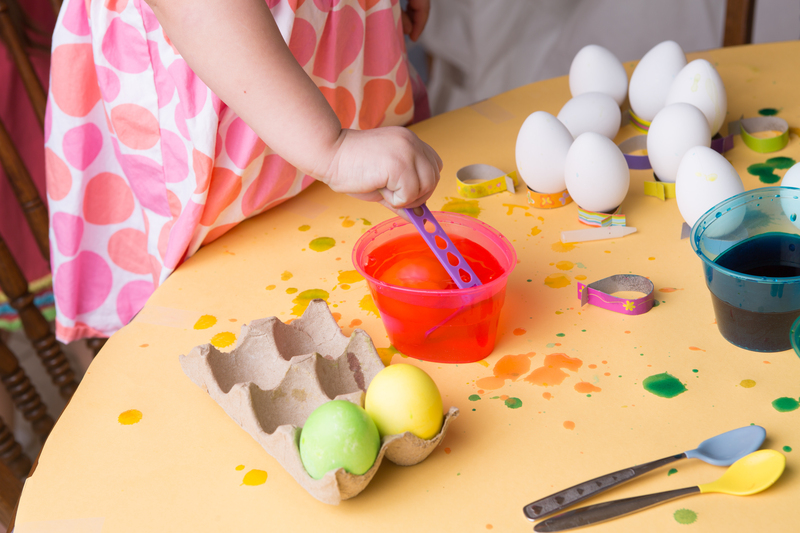Achieve Immaculate Curtains with These Cleaning Tips
Posted on 26/05/2025
Achieve Immaculate Curtains with These Cleaning Tips
Beautiful curtains frame your windows, set the tone of your interiors, and instantly elevate the look of your home. However, even the most stunning fabrics can lose their charm if covered in dust, stains, or odors. If you've ever wondered how to get immaculate curtains that look and smell fresh, you're in the right place. Below, we unveil the best techniques and expert-approved curtain cleaning tips to help you revive your drapes and keep them pristine year-round.
Why Is Cleaning Curtains So Important?
Curtains and drapes aren't just decorative. They are also natural dust magnets. Airborne particles, allergens, pet hair, and even moisture accumulate easily, making regular curtain cleaning a necessity. Here's why maintaining spotless curtains is crucial:
- Air Quality Improvement: Dust-free drapes help keep indoor air cleaner, reducing allergies.
- Longevity: Consistent care preserves the fabric, colors, and texture for years.
- Home Aesthetics: Fresh curtains boost your home's visual appeal and offer a more inviting atmosphere.
- Odor Elimination: Clean drapes eliminate unpleasant smells caused by smoke, pets, or kitchen activities.

Understanding Curtain Fabrics and Care Labels
Before applying any cleaning methods, identify the fabric your curtains are made of and check their care labels. Not all drapes can be treated in the same way:
- Cotton: Often machine-washable but check for shrinkage risks.
- Silk: Needs delicate hand washing or dry cleaning.
- Linen: May require gentle washing or professional treatment.
- Polyester: Easy-care, commonly safe for machine washing.
- Velvet, Suede, or Specialty Materials: Typically dry-clean only.
Always consult the care instructions to avoid any risk of damage. When in doubt, test a small hidden area or consult a cleaning professional.
Pre-Cleaning: Preparing for Curtain Cleaning
Proper preparation leads to better results. Before embarking on your mission to achieve spotless drapes, follow these initial steps:
- Remove Hardware: Take down the curtain rods, hooks, or rings to make washing easier and to protect your hardware from damage.
- Shake Off Dust: Take your curtains outside and give them a gentle shake to remove surface dust and loose dirt.
- Vacuum: Use a vacuum cleaner (with brush attachment) to remove embedded dust, pet hair, and cobwebs, focusing on pleats and folds.
- Spot Test: Apply your chosen cleaning solution to a hidden part of the curtain to check fabric colorfastness and reaction.
Best Methods for Cleaning Curtains at Home
1. Machine Washing Your Curtains
Machine washing is suitable for many curtains, especially those made of cotton, polyester, or blends. Observe the following steps for immaculate results:
- Check Fabric and Instructions: Only machine wash if labeled safe.
- Use a Gentle Cycle: Select a delicate or gentle cycle and cold water to prevent shrinking or fading.
- Mild Detergent: Opt for a non-bleach, mild detergent.
- Wash Separately: Avoid washing with heavy clothing or items with hooks and zippers that could snag the fabric.
- Drying: Hang curtains back up while slightly damp for wrinkle-free results or dry flat on clean towels.
2. Hand Washing Curtains
Some fabrics, especially delicate lace, silk, or embroidered curtains, need to be washed by hand.
- Fill a Bathtub or Basin: Use lukewarm water and a small amount of gentle detergent.
- Soak and Swirl: Immerse the curtains, swirl gently, and soak for 10-15 minutes. Do not wring or twist.
- Rinse Thoroughly: Drain the soapy water and rinse until the water runs clear.
- Dry Carefully: Lay flat or hang to dry naturally. Avoid direct sunlight for fragile fabrics.
3. Steam Cleaning Curtains
For on-the-rod cleaning, a fabric steamer is an excellent and convenient tool. Here's how you can use a steamer for immaculate drapery:
- Begin from the Top: Slowly move the steamer downwards, letting the hot steam loosen dirt and kill dust mites.
- No Chemicals Needed: Steam alone lifts grime and refreshes fabrics.
- Quick Drying: Curtains dry rapidly after steaming, making this method ideal for regular maintenance.
4. Dry Cleaning Curtains
Some curtains, such as velvet or lined drapes, are labeled as dry clean only for a reason. Attempting to wash them at home could cause irreparable damage. In these cases:
- Consult Professionals: Take the curtains to a reputable dry cleaner for expert care.
- Mention Stains: Point out any special stains or fabric concerns.
- Frequency: Dry clean every 12-18 months, or as needed, to maintain freshness and vibrancy.
5. Spot Cleaning for Curtains
For isolated stains, spot cleaning is the answer, allowing you to keep curtains immaculate between washes.
- Blot, Don't Rub: Use a clean, damp cloth to blot up spills instantly.
- Use Fabric-Appropriate Cleaners: For oil, ink, or wine, apply the right stain remover per fabric type.
- Dry Promptly: Use a fan or air dry to prevent water spots or mildew build-up.
How Frequently Should You Clean Your Curtains?
Maintaining spotless drapes doesn't always mean full washing sessions. Adjust your schedule based on fabric type, location, and exposure:
- General Cleaning: Vacuum or shake out curtains every 2 weeks to prevent dust build-up.
- Deep Cleaning: Perform a thorough wash every 3-6 months, or more often if you have pets, allergies, or smokers at home.
- Immediate Action: Spot clean stains or spills as soon as they occur for best results.
- Dry Clean Only Fabrics: Follow professional recommendations but aim for at least once every 12-18 months.
Expert Tips for Immaculate Curtains Year-Round
Maintain Your Curtains Daily
- Keep Windows Closed in High-Pollen Seasons: Reduce the inflow of pollen and dust.
- Use Air Purifiers: They minimize particulate matter, keeping drapes cleaner for longer.
- Rotate Curtains: Swap places if some windows get more sun or traffic -- this minimizes uneven wear and fading.
Use Curtain Linings
- Easy Cleaning: Linings can usually be removed and washed separately, reducing labor and preserving the outer fabric.
- Protects Against Sun: Shield delicate materials from harsh UV rays, preventing fading and deterioration.
Handle Odors and Freshen Curtains
- Baking Soda Sprinkle: Sprinkle a little baking soda, then gently shake or vacuum it off to absorb odors.
- Light Misting: Lightly mist with vinegar-water solution or fabric sprays for a burst of freshness (test first!).
Prevent Mold and Mildew
- Keep Curtains Dry: Avoid letting curtains stay damp. Open windows or run fans after cleaning.
- Ventilation: Make sure there is adequate airflow, especially in bathrooms or kitchens.
Common Curtain Cleaning Mistakes to Avoid
While striving for immaculate curtain results, steer clear of these common pitfalls:
- Overloading the Washer: Cramming too many curtains can lead to subpar washing and wrinkling.
- Ignoring Care Labels: Always read instructions--some fabrics are easily damaged by water or heat.
- Using Harsh Chemicals: Bleach and strong cleaners can degrade fabric quality and cause discoloration.
- Wringing or Twisting: These actions can stretch or wrinkle delicate materials beyond repair.
- Neglecting Regular Maintenance: Waiting too long between cleanings means more dirt, harder stains, and increased allergy risk.

FAQ: Achieving and Maintaining Pristine Curtains
How do I remove stubborn wrinkles from curtains?
Hang curtains while still slightly damp after washing; gravity will help many wrinkles fall out naturally. For tough creases, use a handheld steamer or iron on the fabric's recommended setting, always from the backside.
Can I wash blackout or thermal curtains?
Most blackout and thermal curtains need gentle cleaning. Use a vacuum and spot cleaning primarily, as machine washing may ruin the backing. If a deep clean is needed, follow the care label: some require professional attention.
What's the best way to get rid of pet hair on drapes?
Use a lint roller, microfiber cloth, or a vacuum with a pet hair brush attachment every few days to keep curtains immaculate and allergen-free.
Is it safe to iron all curtain fabrics?
No--some materials like silk and certain synthetics can be burned or melted by heat. Always check the label and iron on the lowest safe setting, using a pressing cloth for protection.
Conclusion: Enjoy Flawless Curtains with Effortless Maintenance
Achieving and maintaining immaculate curtains is possible with a combination of the right cleaning techniques, consistent care, and preventative measures. Whether you prefer machine washing, hand washing, steam cleaning, or professional services, understanding your fabric and following our curtain cleaning tips will ensure your drapes remain fresh, vibrant, and allergy-free for years to come. Make curtain care a regular part of your home cleaning routine--your windows (and guests) will thank you!
Transform your living space today by embracing these proven ways to achieve spotless, immaculate curtains--because clean drapes do more than just decorate; they help your home truly shine.



